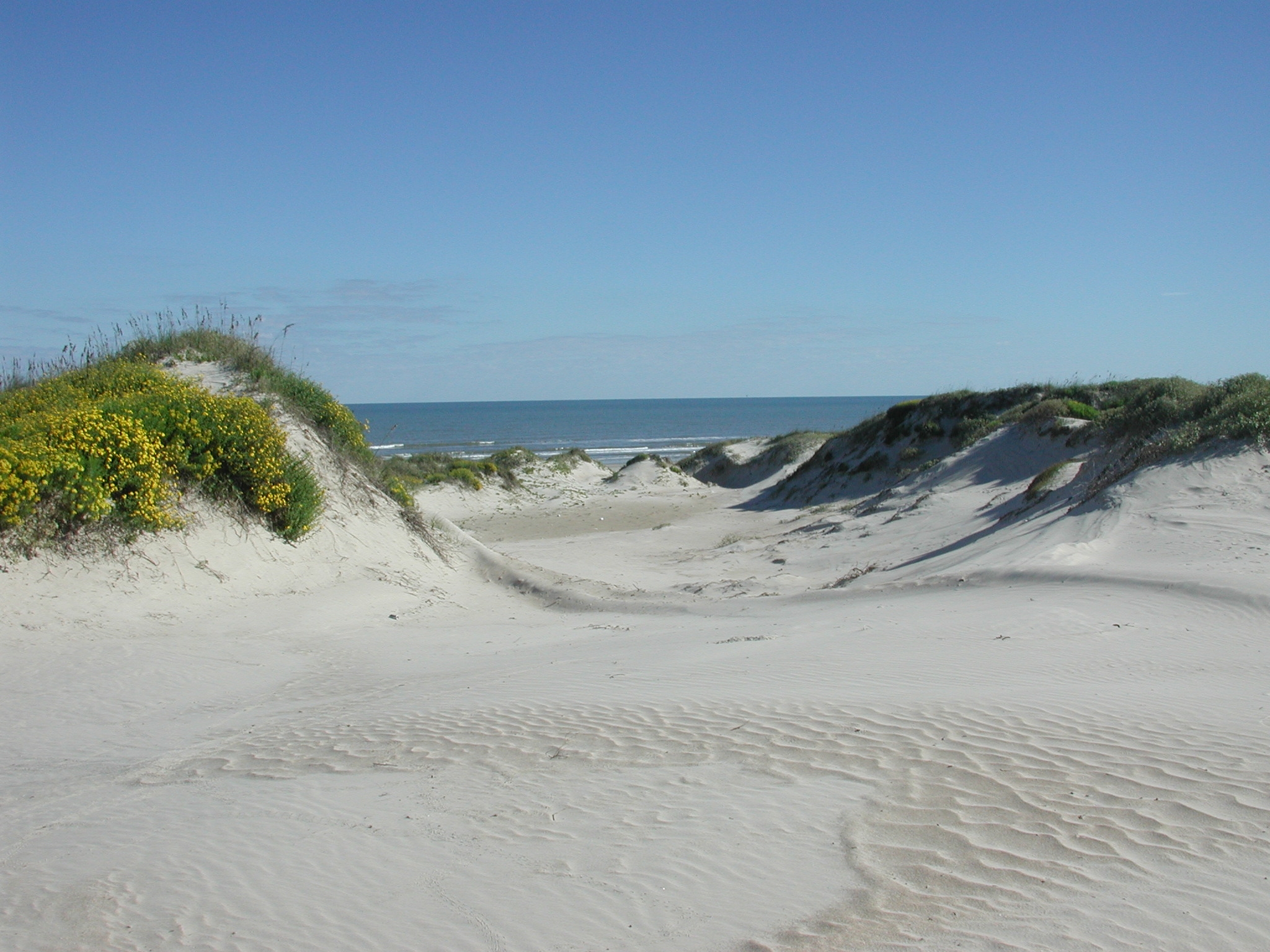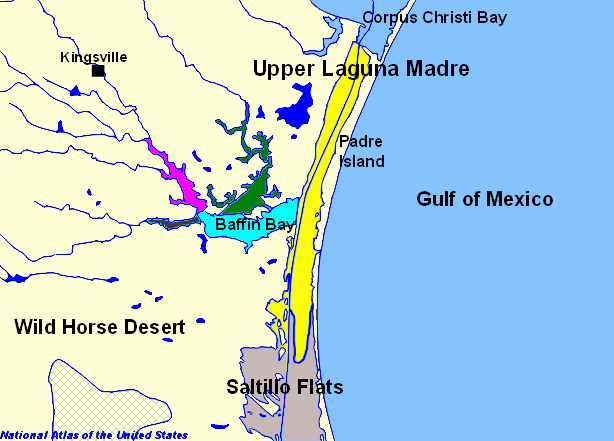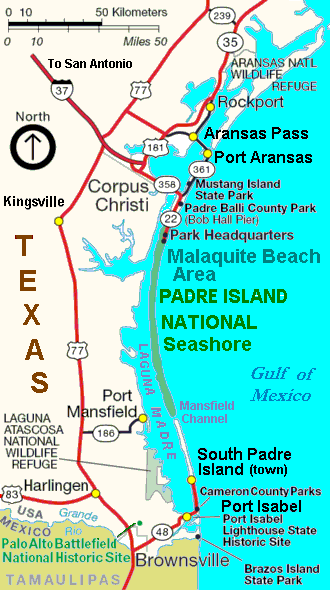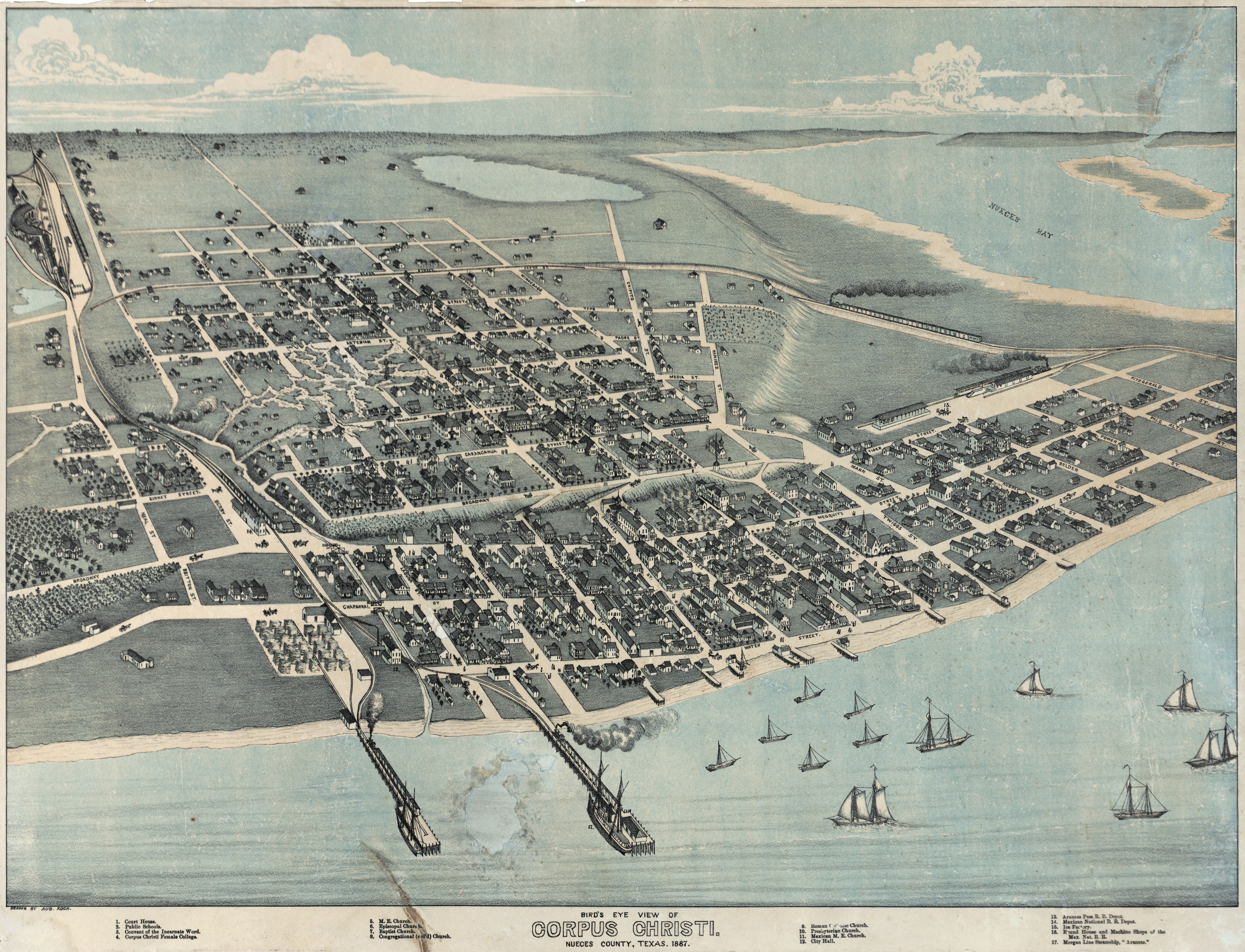|
Padre Island, Texas
Padre Island is the largest of the Texas barrier islands and the world's longest barrier island. The island is located along Texas's southern coast of the Gulf of Mexico and is noted for its white sandy beaches. Meaning ''father'' in Spanish, it was named after Father José Nicolás Ballí (c.1770-1829), who owned the island and served as a missionary priest and collector of finances for all the churches in the Rio Grande Valley. He also founded the first mission in present-day Cameron County. Padre Island is the second-largest island by area in the contiguous United States, after Long Island in New York on the Atlantic Coast. It is about long and wide, stretching from the city of Corpus Christi, in the north, to the resort community of South Padre Island in the south. The island is oriented north-south, bordered by the Gulf of Mexico on the east and Laguna Madre on the west. The island's northern end connects to Mustang Island by roadway. The southern end of the island is ... [...More Info...] [...Related Items...] OR: [Wikipedia] [Google] [Baidu] |
Laguna Madre (United States)
The Laguna Madre is a long, shallow, hypersaline lagoon along the western coast of the Gulf of Mexico in Nueces, Kenedy, Kleberg, Willacy and Cameron Counties in Texas, United States. It is one of seven major estuaries along the Gulf Coast of Texas. The roughly long Saltillo Flats land bridge divides it into Upper and Lower lagoons joined by the Intracoastal Waterway, which has been dredged through the lagoon. Cumulatively, Laguna Madre is approximately long, the length of Padre Island in the US. The main extensions include Baffin Bay in Upper Laguna Madre, Red Fish Bay just below the Saltillo Flats, and South Bay near the Mexican border. As a natural ecological unit, the Laguna Madre of the United States is the northern half of the ecosystem as a whole, which extends into Tamaulipas, Mexico approximately south of the US border, to the vicinity of the Rio Soto La Marina and the town of La Pesca, extending approximately through USA and Mexico in total.Tunnell, Jr. J ... [...More Info...] [...Related Items...] OR: [Wikipedia] [Google] [Baidu] |
Rio Grande Valley (Texas)
The Lower Rio Grande Valley ( es, Valle del Río Grande), commonly known as the Rio Grande Valley or locally as the Valley or RGV, is a region spanning the border of Texas and Mexico located in a floodplain of the Rio Grande near its mouth. The region includes the southernmost tip of South Texas and a portion of northern Tamaulipas, Mexico. It consists of the Brownsville, Harlingen, Weslaco, Pharr, McAllen, Edinburg, Mission, San Juan, and Rio Grande City metropolitan areas in the United States and the Matamoros, Río Bravo, and Reynosa metropolitan areas in Mexico. The area is generally bilingual in English and Spanish, with a fair amount of Spanglish due to the region's diverse history and transborder agglomerations It is home to some of the poorest cities in the nation, as well as many unincorporated, persistent poverty communities called ''colonias''. A large seasonal influx occurs of "winter Texans" — people who come down from the north for the winter and then ... [...More Info...] [...Related Items...] OR: [Wikipedia] [Google] [Baidu] |
Charles III Of Spain
it, Carlo Sebastiano di Borbone e Farnese , house = Bourbon-Anjou , father = Philip V of Spain , mother = Elisabeth Farnese , birth_date = 20 January 1716 , birth_place = Royal Alcazar of Madrid, Spain , death_date = , death_place = Royal Palace of Madrid, Spain , place of burial= El Escorial , religion = Roman Catholicism , signature = Autograph Charles III of Spain.svg Charles III (born Charles Sebastian; es, Carlos Sebastián; 20 January 1716 – 14 December 1788) was King of Spain (1759–1788). He also was Duke of Parma and Piacenza, as Charles I (1731–1735); King of Naples, as Charles VII, and King of Sicily, as Charles V (1734–1759). He was the fifth son of Philip V of Spain, and the eldest son of Philip's second wife, Elisabeth Farnese. A proponent of enlightened absolutism and regalism, he succeeded to the Spanish throne on 10 August 1759, upon the death of his childless half-brother Ferdinand VI. In 1731, the ... [...More Info...] [...Related Items...] OR: [Wikipedia] [Google] [Baidu] |
Spanish Colonization Of The Americas
Spain began colonizing the Americas under the Crown of Castile and was spearheaded by the Spanish . The Americas were invaded and incorporated into the Spanish Empire, with the exception of Brazil, British America, and some small regions of South America and the Caribbean. The crown created civil and religious structures to administer the vast territory. The main motivations for colonial expansion were profit through resource extraction and the spread of Catholicism by converting indigenous peoples. Beginning with Columbus's first voyage to the Caribbean and gaining control over more territory for over three centuries, the Spanish Empire would expand across the Caribbean Islands, half of South America, most of Central America and much of North America. It is estimated that during the colonial period (1492–1832), a total of 1.86 million Spaniards settled in the Americas, and a further 3.5 million immigrated during the post-colonial era (1850–1950); the esti ... [...More Info...] [...Related Items...] OR: [Wikipedia] [Google] [Baidu] |
Land Grant
A land grant is a gift of real estate—land or its use privileges—made by a government or other authority as an incentive, means of enabling works, or as a reward for services to an individual, especially in return for military service. Grants of land are also awarded to individuals and companies as incentives to develop unused land in relatively unpopulated countries; the process of awarding land grants are not limited to the countries named below. The United States historically gave out numerous land grants as Homesteads to individuals desiring to prove a farm. The American Industrial Revolution was guided by many supportive acts of legislatures (for example, the Main Line of Public Works legislation of 1826) promoting commerce or transportation infrastructure development by private companies, such as the Cumberland Road turnpike, the Lehigh Canal, the Schuylkill Canal and the many railroads that tied the young United States together. Ancient Rome Roman soldiers were giv ... [...More Info...] [...Related Items...] OR: [Wikipedia] [Google] [Baidu] |
Karankawa People
The Karankawa were an Indigenous people concentrated in southern Texas along the coast of the Gulf of Mexico, largely in the lower Colorado River and Brazos River valleys."Karankawa." In ''Cassell's Peoples, Nations and Cultures,'' edited by John Mackenzie. Cassell, 2005. They consisted of several independent seasonal nomadic groups who shared the same language and much of the same culture. From the onset of European colonization, the Karankawa had violent encounters with the Spanish. After one attack by the Spanish, who ambushed the Karankawa after the establishment of Presidio La Bahía in 1722, the Karankawa allegedly felt "deeply betrayed ndviewed Spanish colonial settlement with hostility." In the 1820s, Texan colonists arrived in their land under the leadership of Stephen Austin who commissioned a captain to expel the Karankawa from the Austin land grant, leading to multiple attacks, including the Skull Creek massacre of 19 Karankawa. By the 1840s, the Karankawa, now ex ... [...More Info...] [...Related Items...] OR: [Wikipedia] [Google] [Baidu] |
Laguna Atascosa National Wildlife Refuge
Laguna Atascosa National Wildlife Refuge is the largest protected area of natural habitat left in the Lower Rio Grande Valley. The refuge is located almost entirely in Cameron County, Texas (near Harlingen), although a very small part of its northernmost point extends into southern Willacy County. Fauna The Peregrine Fund began reintroducing captive-bred northern aplomado falcons (''Falco femoralis septentrionalis'') to the refuge in 1985, which had been nearly extirpated from the Southwestern United States; today, it is home to 26 pairs. Nine other endangered or threatened species inhabit the refuge, such as the Texas ocelot (''Leopardus pardalis albescens'') and (formerly) the Gulf Coast jaguarundi (''Herpailurus yagouaroundi''), rare wild cats. Programs at the refuge include vegetation and wetland A wetland is a distinct ecosystem that is flooded or saturated by water, either permanently (for years or decades) or seasonally (for weeks or months). Flooding results i ... [...More Info...] [...Related Items...] OR: [Wikipedia] [Google] [Baidu] |
Padre Island National Seashore
Padre Island National Seashore (PINS) is a national seashore located on Padre Island off the coast of South Texas. In contrast to South Padre Island, known for its beaches and vacationing college students, PINS is located on North Padre Island and consists of a long beach where nature is preserved. Most of the park is primitive, but camping is available, and most of the beach is only accessible to four-wheel-drive vehicles. All but four miles is open to vehicle traffic. PAIS is the fourth designated national seashore in the United States.David Sikes of ''Corpus Christi Caller-Times'', "Padre Island seashore marks 50th", ''Laredo Morning Times'', December 3, 2012, p. 3A North Padre Island is the longest undeveloped barrier island in the world. The national seashore is long with of Gulf beach. PAIS hosts a variety of pristine beach, dune, and tidal flat environments, including the Laguna Madre on its west coast, a famous spot for windsurfing. It is located in parts of Klebe ... [...More Info...] [...Related Items...] OR: [Wikipedia] [Google] [Baidu] |
Brazos Island
Brazos Island, also known as Brazos Santiago Island, is a barrier island on the Gulf Coast of Texas in the United States, south of the town of South Padre Island. The island is located in Cameron County. Brazos Santiago Pass partitions the barrier islands of Brazos Island and Padre Island in the Lower Rio Grande Valley The Lower Rio Grande Valley ( es, Valle del Río Grande), commonly known as the Rio Grande Valley or locally as the Valley or RGV, is a region spanning the border of Texas and Mexico located in a floodplain of the Rio Grande near its mouth. The .... References * * "A Decade of Beneficial Use, Brazos Island Harbor, Dredging"by T. Neil McLellan, P.E., Herbie Maurer, P.E., Bob Fudge, P.E., and Dan J. Heilman, P.E. External links * {{authority control Barrier islands of Texas Landforms of Cameron County, Texas State parks of Texas Uninhabited islands of the United States ... [...More Info...] [...Related Items...] OR: [Wikipedia] [Google] [Baidu] |
Mustang Island
Mustang Island is a barrier island on the Gulf Coast of Texas in the United States. The island is 18 miles (29 km) long, stretching from Corpus Christi to Port Aransas. The island is oriented generally northeast–southwest, with the Gulf of Mexico on the east and south, and Corpus Christi Bay on the north and west. The island's southern end connects by roadway to Padre Island. At the northern end of the island is Port Aransas, beyond which is San José Island. The Aransas Channel, also known as the "Aransas Pass," which separates Mustang Island from San José Island, is protected by jetties extending into the Gulf from each island. The town of Port Aransas is located at the northern end of the island. Mustang Island State Park encompasses the entire southern third of the island, including 3,955 acres (1,600 ha) and 5 miles (8 km) of beach. The city of Corpus Christi includes the northernmost portion of Padre Island and part of Mustang Island between Port Ar ... [...More Info...] [...Related Items...] OR: [Wikipedia] [Google] [Baidu] |
South Padre Island, Texas
South Padre Island is a resort town in Cameron County, Texas, United States. It is part of the Brownsville– Harlingen Metropolitan Statistical Area. The population was 2,066 at the 2020 census. The town is located on South Padre Island, a barrier island along the Texas Gulf Coast accessible via the Queen Isabella Causeway from the town of Port Isabel. South Padre Island is named after José Nicolás Ballí (Padre Ballí), a Catholic priest and settler. Storm damage and structure issues Storms * In September 1967, Hurricane Beulah caused extensive damage to much of the town of South Padre Island. * On July 23, 2008, Hurricane Dolly made landfall on the island as a category 1 storm, also causing extensive damage to the town. The Bahia Mar Condominium had extensive damage and had to be gutted due to the damage. * In September 2008 Hurricane Ike caused moderate damage to the island. * In July 2010, the island received heavy rains from Hurricane Alex, but the storm left th ... [...More Info...] [...Related Items...] OR: [Wikipedia] [Google] [Baidu] |
Corpus Christi, Texas
Corpus Christi (; Ecclesiastical Latin: "''Body of Christ"'') is a coastal city in the South Texas region of the U.S. state of Texas and the county seat and largest city of Nueces County, it also extends into Aransas, Kleberg, and San Patricio Counties. It is southeast of San Antonio. Its political boundaries encompass Nueces Bay and Corpus Christi Bay. Its zoned boundaries include small land parcels or water inlets of three neighboring counties. The city's population was 317,863 in 2020, making it the eighth-most populous city in Texas. The Corpus Christi metropolitan area had an estimated population of 442,600. It is also the hub of the six-county Corpus Christi-Kingsville Combined Statistical Area, with a 2013 estimated population of 516,793. The Port of Corpus Christi is the fifth-largest in the United States. The region is served by the Corpus Christi International Airport. The city's name means body of Christ in Ecclesiastical Latin, in reference to the Christian sac ... [...More Info...] [...Related Items...] OR: [Wikipedia] [Google] [Baidu] |






_Laguna_Atascosa_National_Wildlife_Refuge%2C_Texas.jpg)

